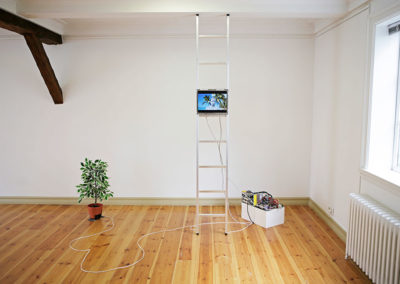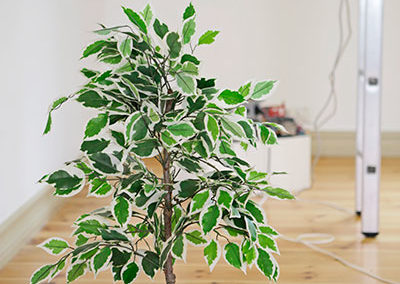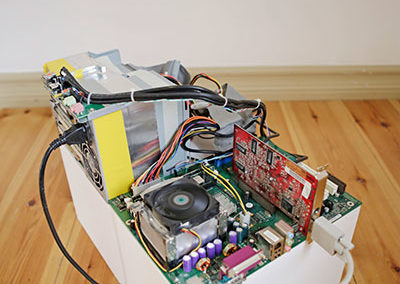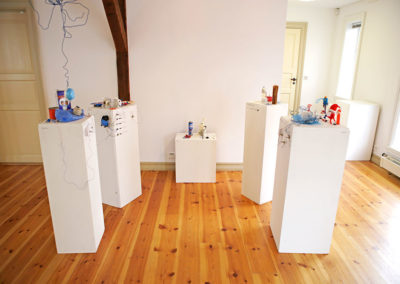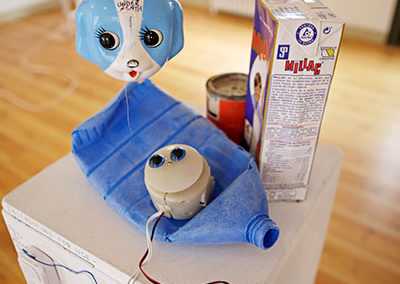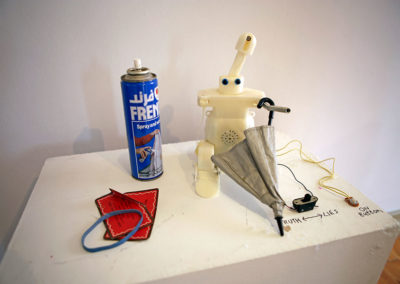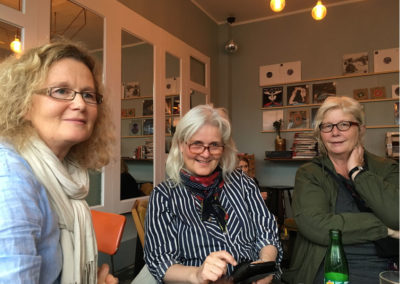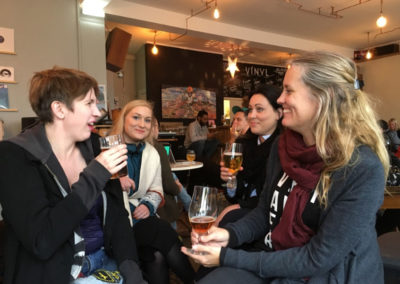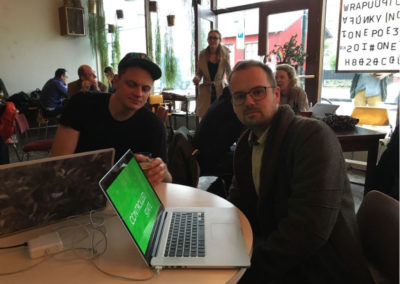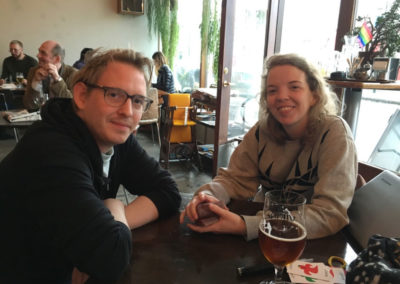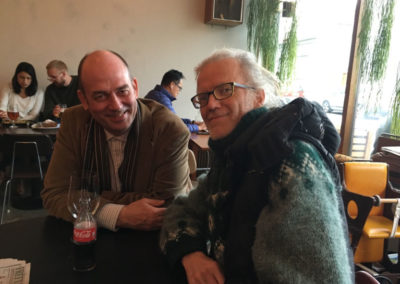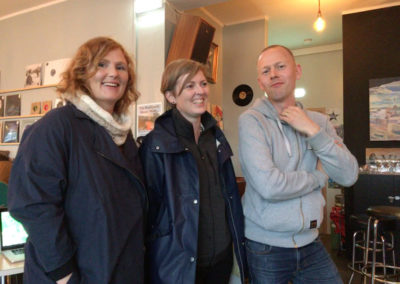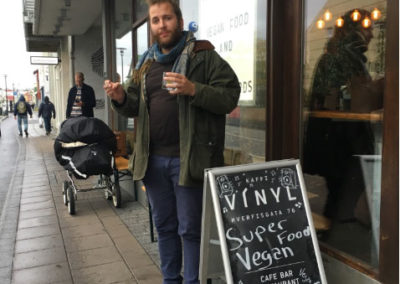


Look at Us

Look at Us
Vulnerable and endangered animals are Halla Gunnarsdóttir´s subject in her exhibition Look at Us. Halla presents 27 oil paintings, all of which portray vulnerable species. The animals are shown with distinctively human features and placed in often humorous poses, settings and situations that strive to evoke an emphatic link between the subject and the viewer. By anthropomorphizing its subjects the work hopes to show that what separates us from animals is very little and, at the same time, to communicate the gravity of the man-made crisis they face.
In the past few years Halla´s body of work has focused on conservation and vulnerable animals, inspired in part by her travels, for example to Antarctica and Indonesia. In September 2015, Halla traveled to the Arctic with a group of scientists and nature photographers to raise awareness of the effects of climate change on the region.
A central tenet of sustainable thought is the need to protect biodiversity, a concept used to define the diverse nature of our habitat. Biodiversity is fundamental to the survival of species and habitats that together make life on the planet. Today we are witnessing an ever greater erosion of biodiversity, which has far-reaching effects on the world’s natural environment and hence on our well-being.
Human interference in the ecosystem is one of the greatest causes of disruption and change in natural habitats. This includes agricultural systems, construction, the mining of natural resources, as well as the depletion of forests, seas, rivers, lakes and soil. It also results in the invasion of foreign species, pollution and climate changes that today are called global warming.

Halla’s figuratively presented animal subjects engaging in human-like actions provoke an emphatic reaction in the viewer. A close look at the paintings strengthens the sense that the distance between humans and animals is not significant. Her work is thus a powerful reminder of the importance of treating nature and animals with respect. This is true everywhere, even in areas like the Arctic where very little life thrives. The exhibition demonstrates that the artist’s travels and studies in the region have had a profound influence on her work. She succeeds in communicating to the viewer the importance of actively participating in conservation efforts.
The most important element in future conservation debates should be the concept of sustainable development. The logic behind it is that in their constant quest for progress and harnessing of natural resources, humans must not deplete natural reserves to the degree that we leave the next generation with a damaged environment.
Polar bears are among many vulnerable species whose lives are in danger from the changes caused by the melting of the polar caps in their natural habitat and which have eroded their chances of feeding themselves. It seems logical that the Icelandic public should care about the danger that many animal species now face. But Árni Stefán Árnason, a lawyer who focuses on animal rights, believes that widespread ignorance characterizes attitudes towards animal rights and conservation. This lack of respect is demonstrated when polar bears are killed when they drift here with Arctic ice. He has pointed out possible solutions: in Canada, for example, when such an event occurs a team is dispatched in a helicopter to shoot the animal with tranquilizers. The animal is then transported to more distant areas. Árni has pointed out that animals that arrive here can be transported back to Greenland using this method.
There is an ongoing debate on what should be done with polar bears that drift to the country. But regardless of people’s opinions it is important that the government formulate a future policy for action since the odds of polar bears drifting to the country have increased with the warming of the seas. An action plan that safeguards biodiversity and protects endangered animals is needed.
Changing circumstances call for a revision of the values and ideas we build our society and economy on. It is important to build on the ideology of sustainable development in which the economy, social equality and environmental conservation join to ensure acceptable living conditions for all inhabitants of the planet.
Works of art are well suited to raise awareness of sustainability issues. The philosopher Sigríður Þorgeirsdóttir discussed the relationship between words and images in her article Long and Short Shadows: The Truman Show. The article is a philosophical meditation on reality and artificial reality. She quotes Herbert Marcuse who believes that men live in ‘a society of organized stupidity […] consumers who are fed by the media and made one-dimensional.’ She points out that Virilo assumes that the image has become more powerful than the written word. The language of images is subtler than the written word because it has easier access to our sensibilities. So long as our eyes are open we are open to visual stimulation, but to read we have put ourselves into a particular state of mind.
The arts are an important part of Education for Sustainability. Such education has to build on a moral foundation that can create a general change in attitudes and lead to a brighter future for all. The arts can affect our emotions, give us inner peace, cause tension, inspire new ideas, provide advice, arouse empathy, make us angry and disturb viewers. The arts can change attitudes. All of the above is true of the work exhibited in Look at Us.
Halla’s exhibition shows that we are here in the hands of a well-educated practitioner of the arts. Halla began her art studies at the Florence Academy of Art and completed an M.F.A in figurative sculpture from the New York Academy of Art in 2003. On graduating she was awarded the NYAA Sculpture Research Fellowship. She also holds a B.A in Liberal Arts from the New School in New York and an MBA from the Sorbonne in París.
The composition and treatment of colour in the exhibition’s works have a powerful effect, to some degree reminiscent of mid-century art. It is not surprising that her background is in Italy.
Halla is rapidly developing her visual imagery and hopefully she will continue on that path, whether in painting or sculpture.
Ásthildur B. Jónsdóttir
Assistant Professor at the Iceland Academy of the Arts
Artists website: hallagunnarsdottir.com

Málefni sjálfbærni og umhverfisverndar með aðferðum myndlistar
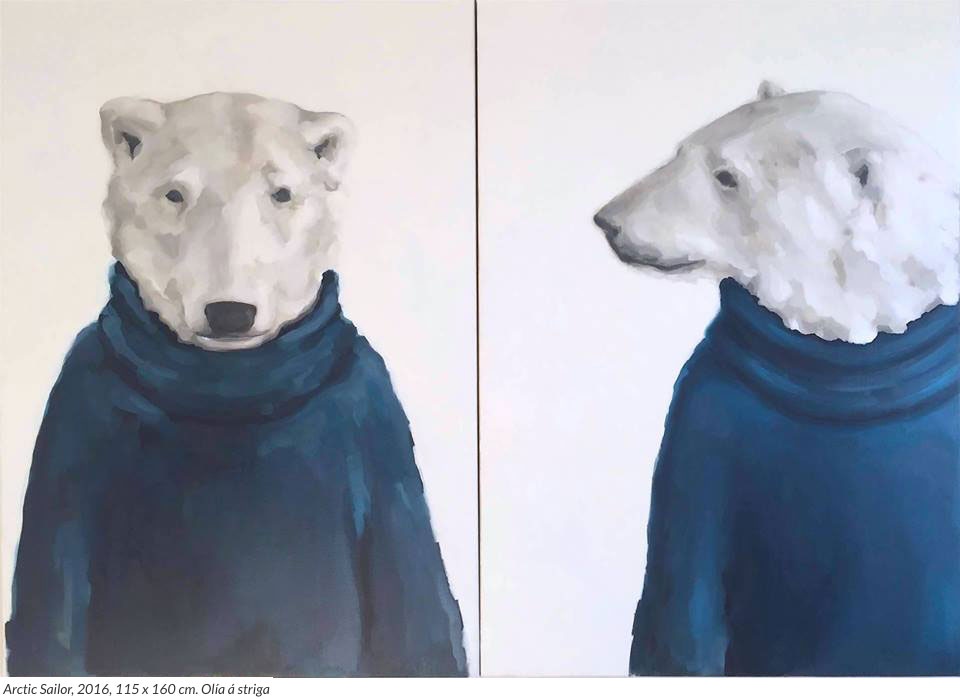
Málefni sjálfbærni og umhverfisverndar með aðferðum myndlistar
Horfðu á okkur: Halla Gunnarsdóttir í Listastofunni Hringbraut 119
Dýr í útrýmingarhættu eru viðfangsefni Höllu Gunnarsdóttur á sýningunni Horfðu á okkur (Look at Us). Um er að ræða 27 olíumálverk sem öll sýna dýrategundir í hættu sem hér er gefin mannleg ásýnd. Dýrin eru sett í skemmtilegar aðstæður sem miða að því að skapa samkennd og tengsl milli áhorfandans og viðfangsefnisins. Með því að manngera viðfangsefnið leitast verkin við sýna að skilin milli manna og dýra eru ekki svo stór og um leið að leggja áherslu á alvarleika þeirrar hættu sem maðurinn hefur skapað þessum dýrum.
Síðastliðin ár hefur Halla unnið að verkum sem fjalla um umhverfisvernd og dýr í útrýmingarhættu en þau hafa orðið til í kjölfar ferðalaga meðal annars til Suðurskautslandsins og Indónesíu. Í september 2015 ferðaðist Halla á norðurslóðir með hópi vísindamanna og náttúrulífsljósmyndara til að vekja athygli á áhrifum loftslagsbreytinga á svæðinu.
Einn af lykilþáttum sjálfbærs samfélags er að hlúa að líffræðilegum fjölbreytileika en það hugtak er notað til að skilgreina margbreytileika lífríkisins. Líffræðilegur fjölbreytileiki styður fjölbreytni tegunda og vistkerfa sem mynda líf á jörðinni. Í síauknum mæli verðum við vitni að tjóni á líffræðilegum fjölbreytileika sem hefur djúpstæð áhrif á náttúru heimsins og velferð manna.
Inngrip mannsins í náttúruna er ein helsta orsök röskunar og breytinga á náttúrulegum búsvæðum. Þar má t.d. telja landbúnaðarkerfi, byggingar, vinnslu hráefna úr jörðu, ofnýtingu á skógum, höfum, fljótum, stöðuvötnum og jarðvegi. Innrás framandi tegunda, mengun og ekki síst hnattrænar loftlagsbreytingar sem í daglegu tali eru kallaðar hlýnun jarðar.
Verk Höllu kalla fram samkennd áhorfandans gagnvart þeim dýrum sem hún hefur sett fram fígúratíft með tengingum við ýmsar mannlegar athafnir. Það ýtir undir þá tilfinningu að þegar vel er að gáð er ekki svo margt sem skilur að menn og dýr. Verkin eru áhrifarík áminning um mikilvægi þess að koma fram við dýr og náttúru af virðingu. Þetta á við alls staðar, jafnvel á hinu svo til lífvana svæði Norðurheimskautsins. Á sýningunni má merkja að ferðir og rannsóknir listakonunnar um það svæði hafa haft sterk áhrif á myndtúlkun hennar. Henni tekst vel að miðla til áhorfandans mikilvægi þess að hlúa að umhverfismálum.
Rauði þráðurinn í umhverfismálum framtíðarinnar ætti að snúast um hugtakið sjálfbæra þróun. Sú hugsun sem þar liggur að baki, er að maðurinn gangi ekki svo á höfuðstól náttúrunnar í framfarasókn sinni og nýtingu náttúrulegra auðlinda að hann skili lakari jörð til næstu kynslóðar.
Hvítabirnir eru meðal þeirra dýrategunda sem nú eru í yfirvofandi útrýmingarhættu vegna breytinga sem bráðnun heimskautaíssins hefur í för með sér á náttúruleg heimkynni þeirra og möguleika til að afla sér fæðu. Ekki er ástæða til annars en að ætla að almenningur á Íslandi láti sig varða þá útrýmingarhættu sem margar dýrategundir nú eru í. Árni Stefán Árnason lögfræðingur, með dýrarétt sem sérsvið, er þó þeirrar skoðunnar að á Íslandi ríki mikið skilningsleysi á dýraverndunarsjónarmiðum. Hann segir virðingarleysi gagnvart dýrum skína í geng þegar hvítabirnir eru felldir eftir að hafa gengið hér á land. Hann hefur bent á mögulegar lausnir: „þegar svona gerist í Kanada eru sérfræðingar sendir á staðinn í þyrlu og þeir látnir skjóta deyfilyfi í dýrið. Síðan er það flutt aftur á fjarlægari slóðir.“ Hann hefur bent á að flytja megi þau dýr sem koma hingað til lands til Grænlands með þessum hætti.
Menn greinir á um hvað gera skuli við þessa hvítabirni sem berast hingað til lands. Sama hvaða afstöðu fólk tekur þá er brýnt að stjórnvöld setji fram aðgerðaráætlun til framtíðar því miklar líkur eru á að hvítabirnir berist í auknum mæli hingað til lands vegna hlýnunar sjávar. Þörf er á aðgerðaráætlun um hvernig tryggja skuli líffræðilega fjölbreytni og vernda dýr í útrýmingarhættu.
Breyttar aðstæður í þjóðfélaginu kalla á endurskoðun þeirra gilda og hugmynda sem við byggjum samfélag og efnahagskerfi okkar á. Mikilvægt er að horfa er til hugmyndafræði sjálfbærrar þróunar þar sem efnahagslíf, félagslegur jöfnuður og umhverfisvernd fara saman í að tryggja öllum jarðarbúum og komandi kynslóðum viðunandi lífsskilyrði.
Listaverk henta mjög vel til að vekja fólk til umhugsunar um málefni sjálfbærni. Sigríður Þorgeirsdóttir heimspekingur fjallaði um samband orða og mynda í greininni Langir og stuttir skuggar: The Truman Show. Greinin er heimspekileg hugleiðing um raunveruleika og sýndarveruleika. Í greininni vitnar hún í Herbert Marcuse sem segir manninn búa í samfélagi skipulagðrar forheimsku […] neytenda sem eru mataðir af fjölmiðlum og steyptir í sama mót. Hún bendir á að Virilo gangi út frá því að myndin sé orðin máttugri en hið ritaða orð. Myndmálið er lúmskara en ritað mál því það á greiðari aðgang að skynjun okkar. Svo fremi sem augu okkar eru opin erum við berskjölduð fyrir sjónrænu áreiti, en við þurfum að setja okkur í stellingar til að lesa texta.

Listir eru mikilvægur liður í menntun til sjálfbærni. Slíka menntun þarf að byggja á siðferðilegum grunni sem gæti skapað almenna viðhorfsbreytingu og leitt til bjartari framtíðar fyrir alla. Listir geta snert við tilfinningum, veitt innri frið, skapað spennu, nýjar hugmyndir, gefið ráð, vakið samkennd, reitt til reiði eða hreyft við áhorfendum. Listir geta breytt viðhorfum. Þetta allt á við þegar verkin á sýningunni Horfðu á okkur eru skoðuð.
Það er ljóst af sýningu Höllu að þarna er á ferðinni vel menntaður listamaður. Hún hóf listnám við Florence Academy of Art í Flórens og lauk M.F.A í fígúratískum skúlptúr frá the New York Academy of Art árið 2003. Við útskrift hlaut hún NYAA Sculpture Research Fellowship. Hún er einnig með B.A í Liberal Arts frá the New School í New York og MBA frá Sorbonne háskóla í París.
Litameðferð og myndbygging verkanna á sýningunni er áhrifamikil og minnir fyrir sumt á myndlistarmenn frá miðri tuttugustu öldinni. Það kemur ekki á óvart að bakgrunnur hennar liggur á Ítalíu.
Halla er í mikilli sókn hvað myndræna hugsun áhrærir og heldur vonandi áfram á þeirri braut hvort heldur sem er í málverki eða höggmyndum.
Höfundur: Ásthildur B. Jónsdóttir
lektor við Listaháskóla Íslands
Article in english: artzine.is/look-at-us
Vefsíða listamannsins: hallagunnarsdottir.com

Unnar Örn J. Auðarson – Efnahagsleg áhrif / Economic Impact 2010- 2016
Unnar Örn J. Auðarson – Efnahagsleg áhrif / Economic Impact 2010- 2016
Unnar Örn J. Auðarson er fjórði myndlistarmaðurinn sem sýnir á Happy hour opnun artzine. Í þetta sinn er hún haldin á Kaffi Vinyl Hverfisgötu 76.
Efnahagsleg áhrif er mikið notað hugtak og stór hluti af orðræðu bæði stjórnmálamanna sem og stórfyrirtækja í samtímanum en Efnahagsleg Áhrif var einnig nafn á tímariti sem gefið var út af Upplýsingaþjónustu Bandaríkjanna – The United States Information Agency á árunum 1972- 1990 til að kynna utanríks og efnahagsstefnu Bandaríkjanna.
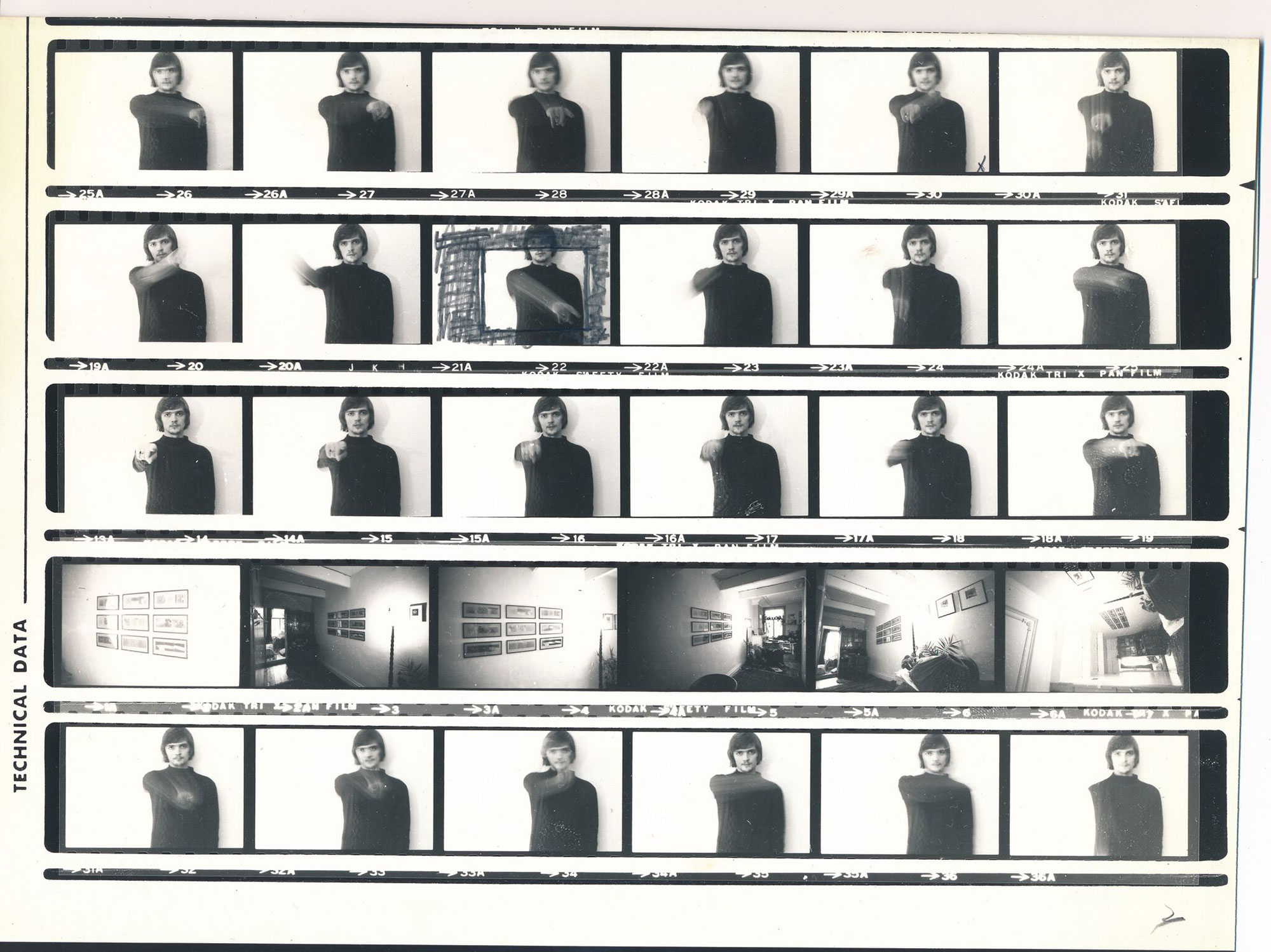
The Living Art Museum (Nýló) receives donation from Ólafur Lárusson’s studio

The Living Art Museum (Nýló) receives donation from Ólafur Lárusson’s studio
The Living Art Museum is endowed with a large selection of material from the studio of artist Ólafur Lárusson (1951 – 2014). Family of the late Ólafur Lárusson, have gifted the Living Art Museum a large portion of material, spanning two decades from around 1970 – 1990, gathered from Ólafur´s art studio. Amongst this donation is part of the artist´s personal library, his film collection, negatives, slides, photographs, sketches, VHS recordings performance documentation, exhibition catalogues and invitations, artistic research and experimentation, as well as proposals for works in the form of drawings, snapshots and conceptualizations that had never been fully realized.
The Living Art Museum will move their exhibition space to the newly renovated Marshall House in Grandi, alongside Kling and Bang Gallery and Ólafur Elíasson. The new space in the harbour will open with a retrospective exhibition echoing Ólafur´s practice and contribution as one from the young and radical generation of contemporary artists who surfaced during the seventies. It will include documentation of his performance work and other substantial material that had not been shared with the public eye during his lifetime and pull together works from The National Gallery of Iceland and Reykjavík Art Museum, along with those in private collection from friends, family, and collectors.
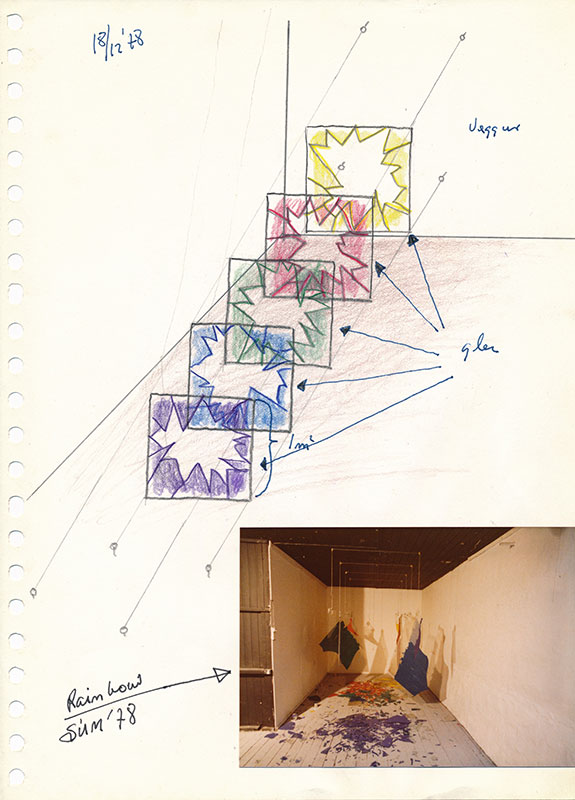
A photograph from Ólafur´s 1978 Rainbow performance in SÚM Gallery.
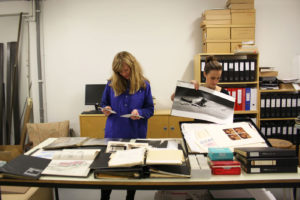 Curators Þorgerður Ólafsdóttir, Director of the Living Art Museum and Collection Manager Becky Forsythe have titled the exhibition Rolling Line, the namesake to a photographic work Ólafur completed in 1975. The artist himself is seen somersaulting through nature within Rolling Line, and the work references the possibility of a continuous line always ending in a circle. This reflection is well related to the core of the exhibition, which aims to shed new light on the process and period of the artist, from 1971 when he started as a student in The Icelandic College of Art and Craft, until the early eighties when Ólafur began to turn away from one of his main mediums, the photograph.
Curators Þorgerður Ólafsdóttir, Director of the Living Art Museum and Collection Manager Becky Forsythe have titled the exhibition Rolling Line, the namesake to a photographic work Ólafur completed in 1975. The artist himself is seen somersaulting through nature within Rolling Line, and the work references the possibility of a continuous line always ending in a circle. This reflection is well related to the core of the exhibition, which aims to shed new light on the process and period of the artist, from 1971 when he started as a student in The Icelandic College of Art and Craft, until the early eighties when Ólafur began to turn away from one of his main mediums, the photograph.
Ólafur Lárusson was born in 1951 and raised in Austur-Meðalholtum, South Iceland and in Hlíðar – 105 Reykjavík. He studied at the Icelandic College of Art and Craft, now Iceland Academy of the Arts, from 1971-74 and subsequently in Haarlem, Holland, where he graduated from Atalier ´63 in 1976. Ólafur was an extremely prolific and productive artist during the seventies and played a key role in shaping the priorities of the icelandic art scene at that time. He was amongst the last artists to be accepted into the SÚM Gallery movement, a founding member of the Living Art Museum, and the first indications of the museum were stored in his studio on Mjölnisholt prior to when the board of Nýló received the facilities at Vatnsstígur 3b in 1980.
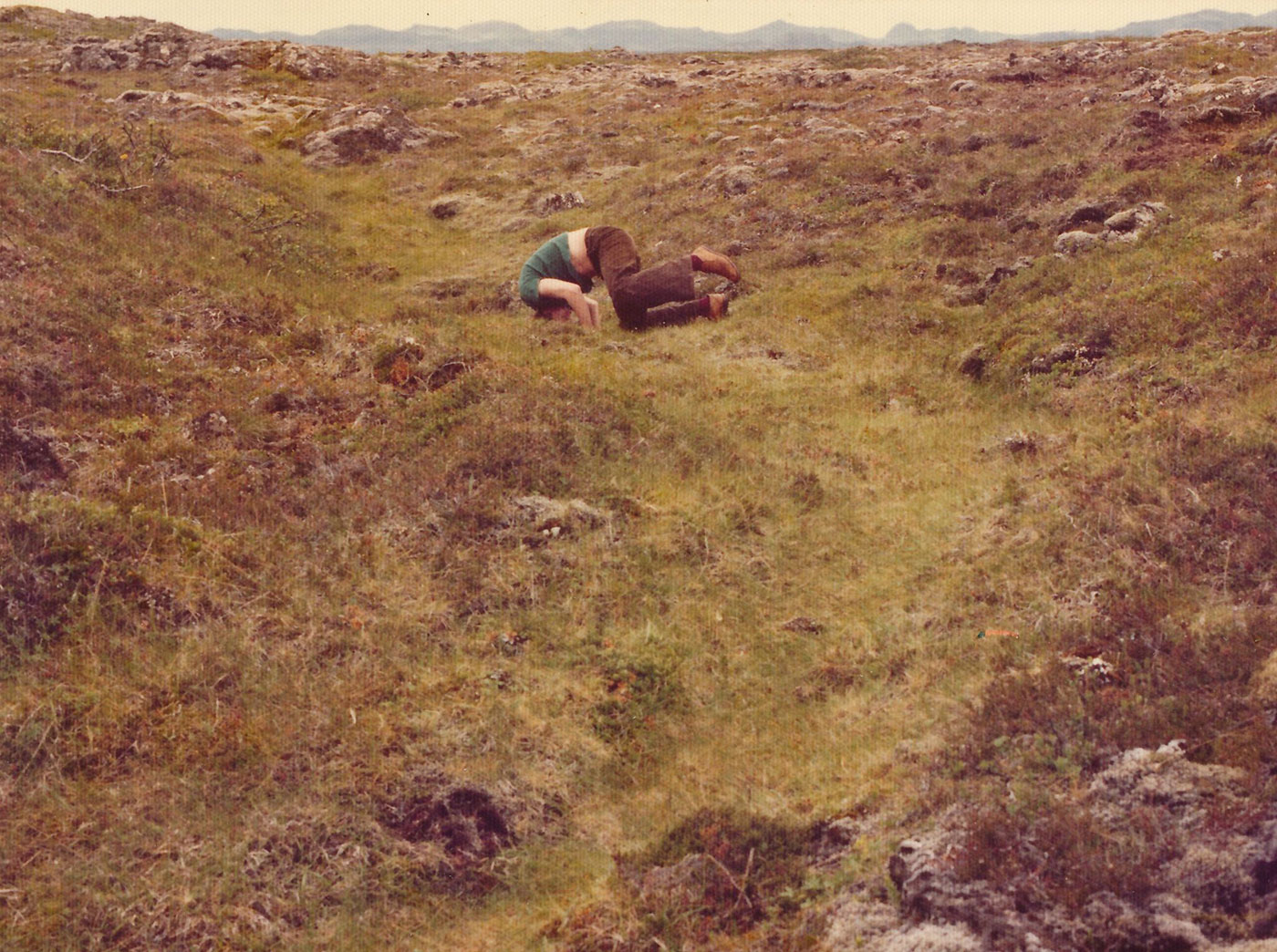 Rolling Line, 1975
Rolling Line, 1975
“The gift from Ólafur´s studio, marks a turning point for Nýló and is also an important addition to art history. The archive is the first of its kind to be accepted by the museum, where light is cast upon the life and practice of the artist in such a way. With the family´s donation, video documentation from Ólafur´s Rainbow performance – which was performed in SÚM Gallery in 1978 and had been lost for many years, has now surfaced. The recording shows the artist breaking hanging glass plates that have been painted the colours of the rainbow, with his head – the broken glass swinging back and forth alongside it.
This contribution also strengthens Nýló´s research into collecting, preserving and archiving performance art, and underlines the immeasurable value of the insight provided through otherwise unseen material gathered over time in the artist´s studio; conceptual-work, the process and evolution of artworks, and specific focuses, streams and remains of certain periods.”
Ólafur passed away on December 4th, 2014. On 10th September he would have celebrated his 65th birthday and the museum would like to take this opportunity to acknowledge his contribution to shaping the scene of Icelandic art.
On behalf of the Living Art Museum,
Þorgerður Ólafsdóttir and Becky Forsythe

